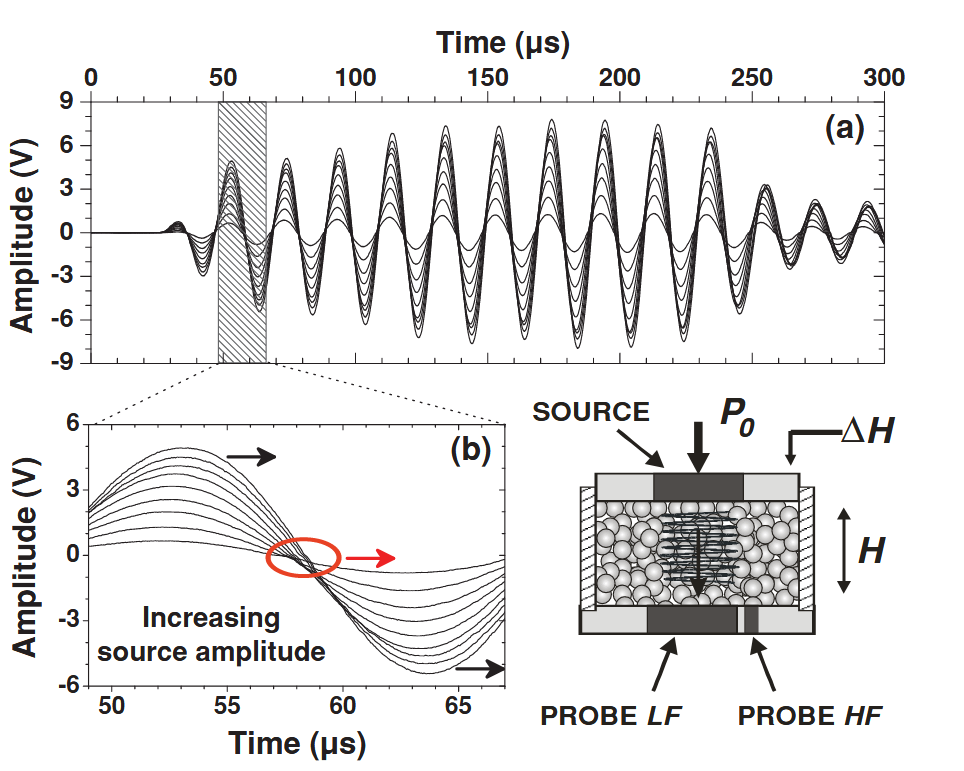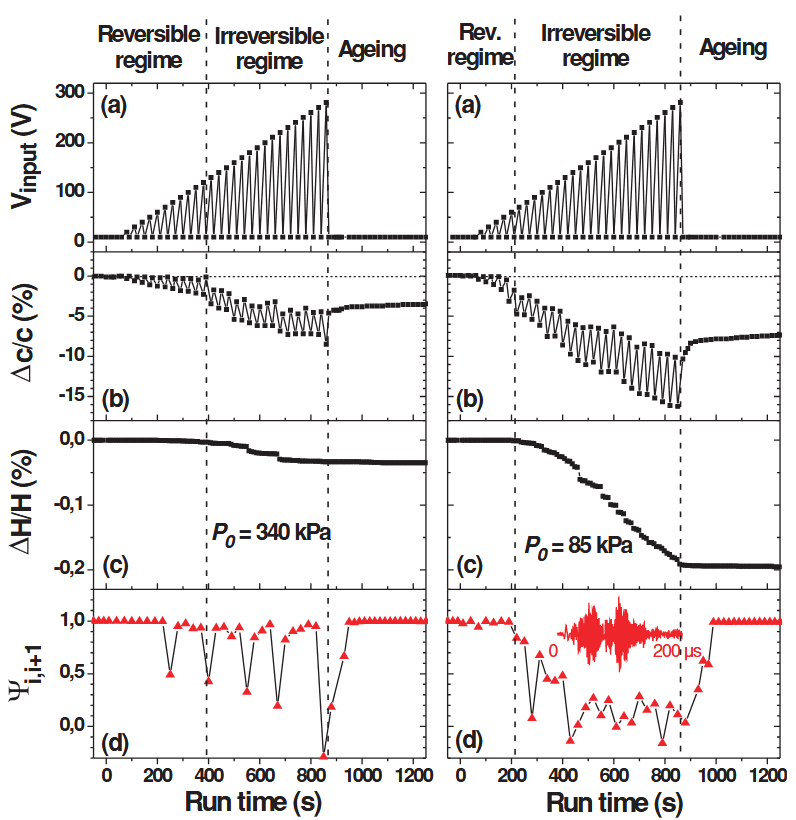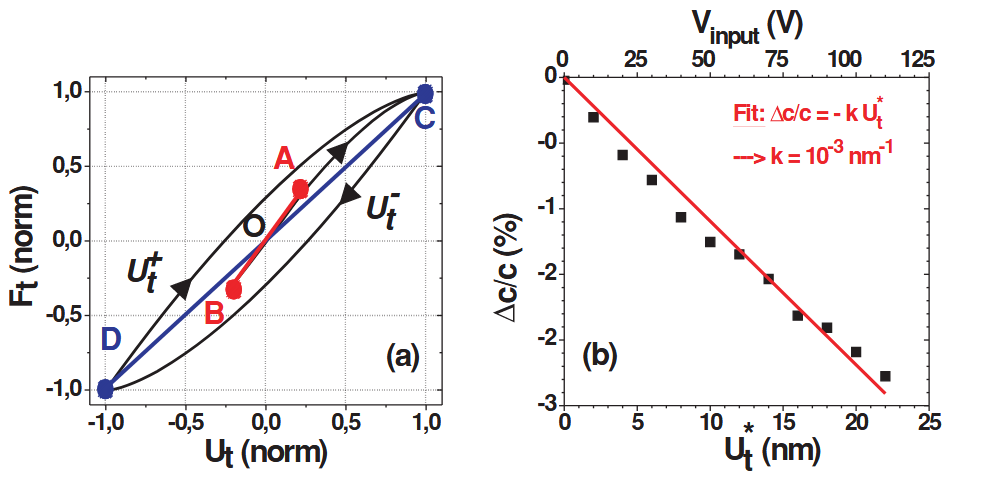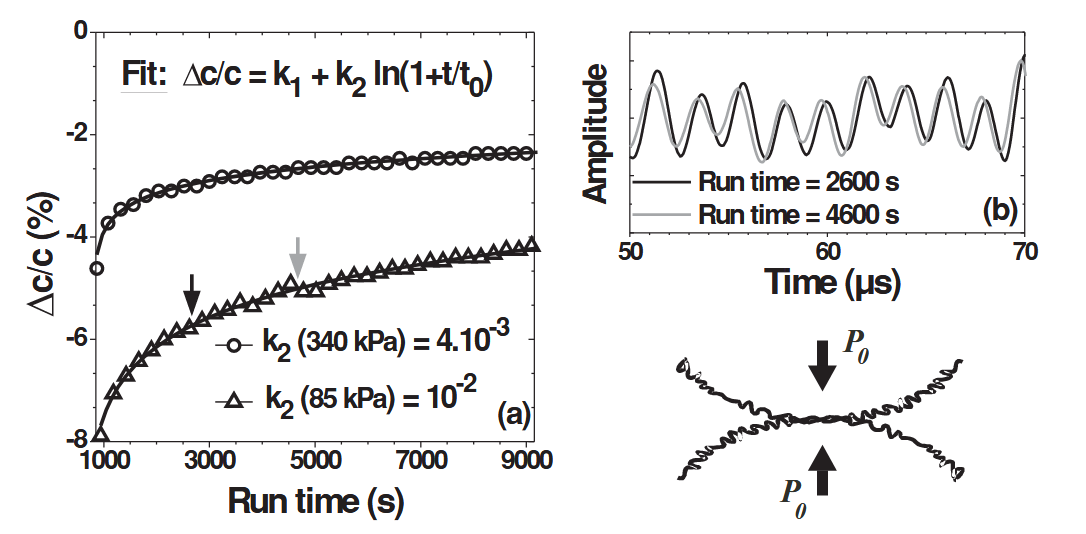Abstract
Sound velocity measurements in dense glass bead packs reveal significant softening effect at large amplitudes, due to the frictional nonlinearity at the grain contacts. Beyond a certain amplitude, the sound-matter interaction becomes irreversible, leaving the medium in a weakened and slightly compacted state. A slow recovery of the initial elastic modulus is observed after acoustic perturbation, revealing the plastic creep growth of microcontacts. The cross-correlation function of configuration-specific acoustic speckles highlights the relationship between the macroscopic elastic weakening and the local change of the contact networks, induced by strong sound vibration, in the absence of appreciable grain motion.
在致密玻璃珠包中进行的声速测量显示,由于晶粒接触处的摩擦非线性,在大振幅时会产生明显的软化效应。超过一定振幅后,声物质相互作用变得不可逆,介质处于减弱和轻微压实状态。在声学扰动之后,可以观察到初始弹性模量的缓慢恢复,揭示了微接触的塑性蠕变增长。构型特定的声学斑点的交叉相关函数强调了宏观弹性减弱与接触网络局部变化之间的关系,这种变化是在没有明显晶粒运动的情况下,由强烈的声学振动引起的。
Introduction
A granular medium is an assembly of discrete macroscopic solid grains that interact with each other by dissipative contact forces. Unlike the ordinary solids and liquids, a dense granular medium exhibits multiple metastable configurations and may undergo a transition between solid state to liquid state when a large enough mechanical force is applied by shear or vibration.
颗粒介质是离散的宏观固体颗粒的集合体,它们通过耗散接触力相互作用。与普通的固体和液体不同,致密的颗粒介质具有多种可变构型,当施加足够大的机械力(如剪切力或振动力)时,颗粒介质可能会从固态转变为液态。
A shaking experiment allows investigation of the complex behavior of driven, athermal granular systems such as compaction, segregation, and pattern formation. In a granular system fluidized by continuous strong vibration where collisions dominate (acceleration normalized with the gravity $\Gamma>1$), it has been shown that an effective viscosity and effective temperature can be defined in such a granular liquid. By decreasing the amplitude of vibration $\Gamma < 1$, the driven granular medium evolves into an amorphous state.
通过振动实验可以研究驱动型非热颗粒系统的复杂行为,如压实、偏析和图案形成。在以碰撞为主的连续强振动(重力加速度归一化为 $\Gamma>1$)的颗粒系统中,已经证明在这样的颗粒液体中可以确定有效粘度和有效温度。通过减小振幅 $\Gamma < 1$,被驱动的颗粒介质会演变成无定形状态。
On the opposite side of the liquid-to-solid transition, the jammed granular state is determined by the inhomogeneous contact force networks. A granular solid exhibits very nonlinear dynamics during shearing, accompanied by strong spatial and temporal variations in the contact distribution. In a weakly vibrated granular column, large force variations have been observed on the bottom boundary in the absence of appreciable grain motion, indicating a strong nonlinear and glassy dynamics of the force network.
在液固转换的另一侧,非均质接触力网络决定了颗粒的堵塞状态。颗粒固体在剪切过程中会表现出极其非线性的动态,同时接触分布也会出现强烈的时空变化。在一个弱振动的颗粒柱中,在没有明显颗粒运动的情况下,在底部边界观察到了很大的力变化,这表明力网络具有很强的非线性和玻璃态动力学。
Sound waves propagating through the contact force network provide a natural way to probe accurately and nondestructively the viscoelastic properties of a jammed granular state. At large amplitude of vibration, sound waves may serve as controlled perturbation to explore the glassy dynamics of a granular solid. Liu and Nagel found previously that sound transmission at $\Gamma\sim 1$ in a glass bead pack under gravity exhibits large temporal fluctuations.
通过接触力网络传播的声波为准确、非破坏性地探测颗粒状态的粘弹性提供了一种自然的方法。在大振幅下,声波可以作为受控扰动来探索颗粒固体的玻璃化动力学。Liu 和 Nagel 之前发现,在重力作用下,玻璃珠组在 $\Gamma\sim 1$ 时的声波传播表现出很大的时间波动。
Unlike the shaking experiment, such structural relaxation, referred to here as “acoustic fluidization”, occurs nevertheless surprisingly where no visible rearrangement of the beads was observed. At moderate vibration ($\Gamma < 0.1$), both a strong hysteretic behavior on the amplitude measurement and a significant modulus softening in the resonance experiment were also observed, but the underlying physics responsible for these nonlinear dynamics still remains unclear on the level of the contacts.
与振动实验不同的是,这种结构松弛在这里被称为 “声学流体化”,但令人惊讶的是,在这种情况下并没有观察到明显的珠子重新排列。在适度振动下($\Gamma < 0.1$),振幅测量中也观察到了强烈的滞后行为,共振实验中也观察到了明显的模量软化,但在接触层面上,这些非线性动力学的基本物理原理仍不清楚。
In this paper, we examine quantitatively the hysteretic characteristics of the sound velocity in jammed granular media via pulsed ultrasonic waves. We focus our attention on the irreversible sound-matter interaction in a regime where the grain motion is visibly absent. The resultant rearrangement of the force network is, however, evidenced by the configurationspecific scattered waves.
在本文中,我们通过脉冲超声波定量研究了堵塞颗粒介质中声速的滞后特性。我们将注意力集中在颗粒运动不明显的情况下不可逆的声-物质相互作用。然而,由此产生的力网络重新排列却可以通过构型特定的散射波得到证明。
Compared to the previous resonance method (~150 s), the velocity measurement reported here (~10 s) is much faster, thus providing an adequate method for highlighting the slow dynamic behavior. All combined measurements, including the packing density, reveal the crucial role of frictional nonlinearity at the grain contact in the elastic weakening and the structural change induced by the acoustic fluidization, and would be helpful for understanding the unjamming or landsliding triggering process.
与之前的共振方法(约 150 秒)相比,这里报告的速度测量(约 10 秒)要快得多,从而为关注缓慢的动态行为提供了合适的方法。包括堆积密度在内的所有综合测量结果都揭示了晶粒接触处的摩擦非线性在声学流化引起的弹性减弱和结构变化中的关键作用,有助于理解解堵或滑坡触发过程。
Experiments
Our granular materials consist of dry polydisperse glass beads of diameter $d = 0.6–0.8\text{ mm}$ confined in a oedometer cell of $60\text{ mm}$ diam which is filled to a height $H = 20\text{ mm}$, with a packing density $\approx 0.61$. This type of apparatus allows us to apply a constant uniaxial load $P_{0}$ on the bead pack from 85 to 340 kPa. A large longitudinal transducer of $30\text{ mm}$ diam is used as a plane-wave source, transmitting a ten-cycle tone burst centered at low frequency, 50 kHz.
我们的颗粒材料由直径为 $d = 0.6-0.8\text{ mm}$ 的干燥多分散玻璃珠组成,这些玻璃珠被装在一个直径为 $60\text{ mm}$ 的颗粒池中,颗粒池的高度为 $H = 20\text{ mm}$,堆积密度约为 $\approx 0.61$。通过这种仪器,我们可以在珠粒上施加从 $85$ 到 $340\text{ kPa}$ 的恒定单轴负载 $P_{0}$。一个直径为 $30\text{ mm}$ 的大型纵波传感器被用作平面波源,发射以 $50\text{ kHz}$ 低频为中心的十周期音爆。
The corresponding wavelength $\lambda$ is $\approx 15\text{ mm}$, which is much larger than the bead size $d$, and the coherent wave propagation is detected by another large transducer at the bottom (inset of Fig. 1). To examine the nonlinear response, we vary the input voltage $V_{\text{input}}$ from 10 to 250 V, corresponding to a vibration displacement $U \approx 2–50\text{ nm}$.
相应的波长 $\lambda\approx 15\text{ mm}$,远大于珠子的尺寸 $d$,相干波的传播由底部的另一个大型传感器检测到(图 1 的插图)。为了检查非线性响应,我们将输入电压 $V_{\text{input}}$ 从 $10\text{ V}$ 变为 $250\text{ V}$,对应的振动位移 $U \approx 2-50 \text{ nm}$。
Figure 1(a) shows typical ultrasound transmissions through the bead pack under $P_{0} = 340\text{ kPa}$ for increasing input amplitudes. The absolute value of sound speed c0 can be measured by the time-of-flight $T_{0}$ as $c_{0} \approx 770\text{ m/s}$. As the input amplitude is increased, we observe that the total transmitted ultrasound is delayed progressively up to ~$2\%$ [Fig. 1(b)]. Such softening effect of sound velocity appears basically different from the usual waveform distortion caused by anharmonicity.
图 1(a) 显示了在 $P_{0} = 340\text{ kPa}$, 输入振幅不断增大的情况下,超声波通过球珠堆积的典型传输情况。声速 $c_{0}$ 的绝对值可通过飞行时间 $T_{0}$ 测得,即 $c_{0}\approx 770\text{ m/s}$。随着输入振幅的增大,我们观察到总的超声波传输时间逐渐延迟到 ~$2\%$ [图 1(b)]。声速的这种软化效应与非谐波引起的一般波形失真基本不同。

(a) Transmitted ultrasonic wave trains through a glass bead pack under $P_{0} = 340\text{ kPa}$ excited by increasing $V_{\text{input}}$. (b) Progressive delay (closeup). Inset: experimental setup including the source transducer and probes of coherent (LF) and scattered (HF) waves.
(a) 在 $P_{0} = 340\text{ kPa}$ 条件下,通过增加 $V_{\text{input}}$ 激发的玻璃珠堆积的透射超声波列。(b) 逐渐延迟(特写)。插图:实验装置,包括声源换能器和相干波(低频)与散射波(高频)探头。
The main investigation is focused on the reversibility of the sound-matter interaction for increasing sound amplitude (Fig. 2); we check if there is any change in the material property and structure after the sound transmission. To do so, measurements of the wave velocity and the packing density are carried out repeatedly at the lowest input amplitude ($V_{\text{input}} = 10\text{ V}$) as a nondisturbing probe, before going up to the next increased amplitude [Figs. 2(a)–2(c)]. In order to monitor the possibly induced rearrangements inside the force networks, we also employ low-amplitude ($V_{\text{input}} = 30\text{ V}$), high-frequency ($f = 500\text{ kHz}$), multiply scattered waves probed by a pinducer [insets of Figs. 1 and 2(d)].
我们的主要研究重点是声波振幅增大时声物质相互作用的可逆性(图 2);我们要检查声波传播后材料的性质和结构是否发生了变化。为此,我们先在最低输入振幅($V_{\text{input}} = 10\text{ V}$)下反复测量波速和堆积密度,作为非扰动探针,然后再测量下一个增大的振幅[图 2(a)-2(c)]。为了监测力网络内部可能诱发的重新排列,我们还采用了低振幅($V_{\text{input}} = 30\text{ V}$)、高频率($f = 500\text{ kHz}$)、多散射波(由一个针形探针探测)[图 1 和图 2(d)的插页]。
The structure changes may be evaluated by these configuration-specific acoustic speckles, via the resemblance parameter $\Psi_{i,i+1} = C_{i,i+1}(\tau = 0)/[C_{i,i}(0)C_{i+1, i+1}(0)]^{1/2}$ that was used previously. Here $C_{i,i+1}(\tau)$ with the time lag $\tau$ is the cross-correlation function between two successive speckle signals $S_{i}(t)$ and $S_{i+1}(t)$ recorded every $30\text{ s}$, before and after the high-amplitude sound transient at low frequency ($f = 50\text{ kHz}$).
通过之前使用的相似性参数 $\Psi_{i,i+1} = C_{i,i+1}(\tau = 0)/[C_{i,i}(0)C_{i+1, i+1}(0)]^{1/2}$ ,可以通过这些对构型敏感的声学斑点来评估结构变化。这里,时滞为 $\tau$ 的 $C_{i,i+1}(\tau)$是在低频($f = 50\text{ kHz}$)高振幅声音瞬态前后每隔 $30\text{ s}$记录的两个连续斑点信号 $S_{i}(t)$ 和 $S_{i+1}(t)$ 之间的交叉相关函数。

Reversible and irreversible interactions between sound waves and granular packs under $P_{0} = 340\text{ kPa}$ (left) and $P0 = 85\text{ kPa}$ (right) versus sound amplitude. (a) Excitation protocol; (b) sound velocity change; (c) packing height variation; (d) resemblance parameter between two successive acoustic speckles. Inset of (d) shows a typical acoustic speckle.
在 $P_{0} = 340\text{ kPa}$ (左)和 $P_{0} = 85\text{ kPa}$ (右)条件下,声波与颗粒堆积之间的可逆和不可逆相互作用与声幅的关系。(a) 激励协议;(b) 声速变化;(c) 堆积高度变化;(d) 两个连续声波斑点之间的相似参数。(d) 的插图显示了一个典型的声学斑点。
Roughly, we identify two regimes of fast nonlinear dynamics versus $V_{\text{input}}$. In the first regime, the interaction between sound wave and granular medium is reversible: There is neither velocity change nor sample density variation after the wave passage and the force network remains nearly unchanged, i.e., $\Psi_{i,i+1} \approx 1$, except for a few rare events. In the second regime, however, beyond a certain amplitude threshold depending on the applied load, the sound-matter interaction becomes irreversible.
我们大致确定了快速非线性动力学与 $V_{\text{input}}$ 的两种机制。在第一种情况下,声波与颗粒介质之间的相互作用是可逆的:声波通过后,既没有速度变化,也没有样本密度变化,力网络几乎保持不变,即 $\Psi_{i,i+1} \approx 1$,少数罕见事件除外。然而,在第二种情况下,根据施加的载荷,超过一定的振幅阈值后,声物质相互作用就变得不可逆了。
Indeed, the wave velocity and corresponding elastic modulus remain weakened after the wave transient, and slight plastic deformation is also observed corresponding to a compaction of ~$0.5 \mu\text{m}$ for one bead layer [Fig. 2(c)]. This characteristic scale associated with our sample compaction is negligibly small compared to those observed in shaking experiments where the rearrangement occurs on the length scale of the grain size $d$ ($\approx 0.7 \text{ mm}$).
事实上,波速和相应的弹性模量在瞬态波之后仍然减弱,而且还观察到轻微的塑性变形,对应于一个珠层 ~$0.5 \mu\text{m}$ 的压实[图 2(c)]。与振动实验中观察到的重排发生在晶粒尺寸 $d$ 的长度尺度上($\approx 0.7 \text{mm}$)相比,与我们的样品压实相关的这一特征尺度可以忽略不计。
However, the resemblance parameter shows a significant intermittent change in the force networks induced by high-amplitude sound waves, which become much more pronounced and frequent under lower confining pressure [Fig. 2(d)] in conjunction with a more important velocity softening and material compaction [Figs. 2(b)–2(c)]. This finding highlights the relationship between the macroscopic elastic weakening and the local change of the contact network, induced by strong sound vibration in the absence of visible grain motion.
然而,相似度参数显示,高振幅声波诱导的力网络发生了显著的间歇性变化,在较低的约束压力下,这种变化变得更加明显和频繁[图 2(d)],同时出现了更重要的速度软化和材料压实[图 2(b)-2(c)]。这一发现凸显了宏观弹性减弱与接触网络局部变化之间的关系,在没有肉眼可见的颗粒运动的情况下,强烈的声波振动会诱发接触网络的局部变化。
Moreover, we find that there exists a slow dynamics (i.e., aging) in the granular medium, left in a weakened state by the irreversible interaction. The sound velocity slowly returns to its initial value over a number of hours after strong sound transmission [Fig. 2(b)]. This slow recovery, roughly following a logarithmic law, is analogous to the stress relaxation in sheared and compressed granular systems and the aging effect of load-bearing asperities between two rough solids (see next section). During this aging process, the resemblance parameter is close to $\Psi_{i,i+1}\approx 1$, implying that the contact force network remains almost unchanged.
此外,我们还发现,颗粒介质中存在一种缓慢的动态变化(即老化),在不可逆的相互作用下处于减弱状态。声速在强声传播后的若干小时内缓慢恢复到初始值[图 2(b)]。这种缓慢的恢复大致遵循对数规律,类似于剪切和压缩颗粒系统中的应力松弛以及两个粗糙固体之间承重凸面的老化效应(见下一节)。在这个老化过程中,相似度参数接近于 $\Psi_{i,i+1}\approx 1$,这意味着接触力网络几乎保持不变。
Modeling and Discussion
Let us interpret the sound velocity softening within the framework of the effective medium approach based on contact mechanics. For small-amplitude sound waves propagating in elastic sphere packs under isotropic compression, both compressional and shear velocities $c_{p}$ and $c_{s}$ can be derived from the incremental normal and tangential stiffness $D_{n}$ and $D_{t}$ , $c_{p}\propto [Z(D_{n}+2D_{t}/3)]^{1/2}$ and $c_{s}\propto [Z(D_{n}+3D_{t} /2)]^{1/2}$ with $Z$ the coordination number.
让我们在基于接触力学的等效介质方法框架内解释声速软化。对于在各向同性压缩条件下在弹性球堆积中传播的小振幅声波,压缩波速度和剪切波速度 $c_{p}$ 和 $c_{s}$ 都可以从增量法向和切向刚度 $D_{n}$ 和 $D_{t}$ 推导出来、$c_{p}\propto [Z(D_{n}+2D_{t}/3)]^{1/2}$ 和 $c_{s}\propto [Z(D_{n}+3D_{t} /2)]^{1/2}$,其中 $Z$ 为配位数。
For large-amplitude sound propagation in the reversible regime $F_{t} < \mu F_{0}$, where $F_{0}$ and $F_{t}$ are the normal and tangential forces at the contact and $\mu$ the coefficient of friction, two distinct kinds of nonlinear elasticity may come into play between two spheres at large-amplitude vibration.
对于可逆状态下的大振幅声传播 $F_{t}< \mu F_{0}$,其中 $F_{0}$ 和 $F_{t}$ 是接触处的法向力和切向力,$\mu$ 是摩擦系数,在大振幅振动时,两个球体之间可能会出现两种不同的非线性弹性。
We first consider the nonlinear effects related to the normal force-displacement response. If an oscillating force $F_{n}$ is applied to two spheres of diameter $d$ initially compressed by a static force $F_{0}$, the oscillating displacement $U_{n}$ can be related to $F_{n}$ by $F_{n}\approx D_{n}U_{n}(1 + \beta U_{n} + \delta U_{n}^{2} + \dots)$. Here $D_{n}$ is the previously mentioned linear stiffness, $\beta = −1/(4U_{0}) (>0)$ and $\delta = −1/(24U_{0}^{2} ) (< 0)$ correspond to the quadratic and cubic nonlinear terms determined by the static compression $U_{0}\sim F_{0}^{2/3} (U_{0}< 0)$.
我们首先考虑与法向力-位移响应有关的非线性效应。如果对两个最初由静态力 $F_{0}$ 压缩的直径为 $d$ 的球体施加振荡力 $F_{n}$,振荡位移 $U_{n}$ 与 $F_{n}$ 的关系为 $F_{n}\approx D_{n}U_{n}(1 + \beta U_{n} + \delta U_{n}^{2} + \dots)$。这里的 $D_{n}$ 是之前提到的线性刚度,$\beta = -1/(4U_{0}) (>0)$ 和 $\delta = -1/(24U_{0}^{2} ) (<0)$ 分别对应于由静态压缩 $U_{0}\sim F_{0}^{2/3} (U_{0}< 0)$ 决定的二阶和三阶非线性项。
Accordingly, at large amplitude, we have an associated normal stiffness over one cycle of oscillation $D_{n}^{\text{NL}}\approx D_{n}(1 + \delta U_{n}^{2})$ and a resultant softening of sound velocity $\Delta c/c\sim \Delta D_{n}/D_{n}\sim \delta U_{n}^{2}$. Under a pressure $P_{0}( = 4F_{0}/\pi d^{2}) \approx 100\text{ kPa}$, the static compression is $U_{0} \approx –120\text{ nm}$ (the static strain $\varepsilon_{0}\sim U_{0}/d\approx –2\times 10^{−4}$) and $\delta \approx –3\times 10^{−6}\text{ nm}^{−2}$. For a sound wave of $U_{n}\approx 6\text{ nm}$ (the acoustic strain $\varepsilon_{a}\sim U_{n}/d\approx 10^{-5}$), the velocity softening due to the Hertz nonlinearity would be only $\Delta c/c\sim –0.01\%$. This mechanism, suggested previously, is thus not responsible for the experimental finding (~$–2\%$).
因此,在大振幅下,一个振荡周期内的相关法向刚度为 $D_{n}^{\text{NL}}\approx D_{n}(1 + \delta U_{n}^{2})$ , 声速随之变软 $\Delta c/c\sim \Delta D_{n}/D_{n}\sim \delta U_{n}^{2}$ 。 在压力 $P_{0}( = 4F_{0}/\pi d^{2}) \approx 100\text{ kPa}$ 下, 静态压缩为 $U_{0} \approx –120\text{ nm}$(静态应变 $\varepsilon_{0}\sim U_{0}/d\approx –2\times 10^{−4}$)和 $\delta \approx -3\times 10^{-6}\text{ nm}^{-2}$.对于 $U_{n}\approx 6\text{ nm}$ 的声波(声学应变 $\varepsilon_{a}\sim U_{n}/d\approx 10^{-5}$),赫兹非线性导致的速度软化仅为 $\delta c/c\sim -0.01\%$。因此,之前提出的这一机制并不是实验结果(~$-2\%$ )的原因。
Let us now examine another mechanism of nonlinearity at the contact, i.e., the hysteretic friction. For two identical spheres, compressed by a constant normal force $F_{0}$, an analytical relationship can be derived between the tangential displacement $U_{t}$ and force $F_{t}$ , before the sliding threshold (i.e., the Mindlin model). As depicted in Fig. 3(a), OA and OC represent, respectively, the normalized loading curves for small and large amplitude ($U_{t}^{*}$) of the transverse displacement; AB- BA and CD-DC correspond to the cyclic unloading-reloading curves.
现在让我们来研究接触处的另一种非线性机制,即滞后摩擦。对于受到恒定法向力 $F_{0}$ 压缩的两个完全相同的球体,在滑动阈值(即 Mindlin 模型)之前,切向位移 $U_{t}$ 和力 $F_{t}$ 之间存在一种解析关系。如图 3(a) 所示,OA 和 OC 分别代表横向位移小振幅($U_{t}^{*}$)和大振幅($U_{t}^{*}$)时的归一化加载曲线;AB- BA 和 CD-DC 分别对应循环卸载-重新加载曲线。

(a) Tangential loading-displacement hysteresis loop: $F_{t}$ and $U_{t}$ are normalized by $\mu F_{0}$ and $U_{t}$ obtained at $F_{t} = \mu F_{0}$, respectively. (b) Comparison between measurements and predictions (solid line).
(a) 切向加载-位移滞回线:$F_{t}$ 和 $U_{t}$ 分别以 $F_{t} = \mu F_{0}$ 和 $U_{t}$ 在 $F_{t} = \mu F_{0}$ 时得到的结果进行归一化。(b) 测量值与预测值的比较(实线)。
For large amplitude of vibration, unloading ($U_{t}^{-}$) and reloading ($U_{t}^{+}$) displacements form a significant hysteresis loop versus $F_{t}$ (of amplitude $F_{t}^{*}$), implying both the dissipative and the nonlinear elastic features of solid friction. The average stiffness $D_{t}^{\text{NL}}$ corresponds to the slope of the line connecting the end points C and D: $D_{t}^{\text{NL}} < D_{t}$ when increasing the amplitude $U_{t}^{*}$.
对于大振幅振动,卸载($U_{t}^{-}$)和重载($U_{t}^{+}$)位移相对于 $F_{t}$(振幅为 $F_{t}^{*}$)形成一个显著的滞后环,这意味着固体摩擦具有耗散和非线性弹性特征。平均刚度 $D_{t}^{\text{NL}}$ 与连接端点 C 和 D 的直线斜率相对应:当振幅 $U_{t}^{*}$ 增大时, $D_{t}^{\text{NL}} < D_{t}$.
Such softening effect can also be deduced from the elastic response ($U_{t}^{E}$) and the dissipative counterpart ($U_{t}^{H}$) of the hysteretic behavior $U_{t}(F_{t}) = U_{t}^{E}(F_{t}) + SU_{t}^{H}(F_{t})$, as in rocks. Here $U_{t}^{E} = (U_{t}^{+} + U_{t}^{-})/2$, $U_{t}^{H} = (U_{t}^{+} - U_{t}^{-})/2$, and $S$ is a sign function, $S = 1 (–1)$ for $F_{t}$ increasing (decreasing). For $F_{t}^{*}$, we may derive from the Mindlin model (i.e., unloading-reloading),
$$ \begin{aligned} U_{t}^{E}(F_{t}) &\approx \frac{2U_{0}}{3}\left(1 + \frac{F_{t}^{*}}{6\mu F_{0}}\right)\frac{F_{t}}{\mu F_{0}}\\ U_{t}^{H}(F_{t}) &\approx \frac{U_{0}}{18}\left[\left(\frac{F_{t}}{\mu F_{0}}\right)^{2} - \left(\frac{F_{t}^{*}}{\mu F_{0}}\right)^{2}\right] \end{aligned} $$
这种软化效应也可以从滞后行为的弹性响应($U_{t}^{E}$)和耗散对应效应($U_{t}^{H}$)中推导出来,如岩石中的 $U_{t}(F_{t}) = U_{t}^{E}(F_{t}) + SU_{t}^{H}(F_{t})$ 所示。这里 $U_{t}^{E} = (U_{t}^{+} + U_{t}^{-})/2$,$U_{t}^{H} = (U_{t}^{+} - U_{t}^{-})/2$,$S$ 是符号函数,$S = 1 (-1)$ 表示 $F_{t}$ 增加(减少)。对于 $F_{t}^{*}$,我们可以从 Mindlin 模型(即卸载-重载)中得出:
$$ U_{t}^{E}(F_{t}) \approx \frac{2U_{0}}{3}\left(1 + \frac{F_{t}^{*}}{6\mu F_{0}}\right)\frac{F_{t}}{\mu F_{0}}\tag{(1a)}\label{eq:1a} $$
$$ U_{t}^{H}(F_{t}) \approx \frac{U_{0}}{18}\left[\left(\frac{F_{t}}{\mu F_{0}}\right)^{2} - \left(\frac{F_{t}^{*}}{\mu F_{0}}\right)^{2}\right] \tag{(1b)}\label{eq:1b} $$
In this work, we are only concerned with the elastic response $\eqref{eq:1a}$; the tangential stiffness is obtained by $D_{t}^{\text{NL}} = \left(\frac{\mathrm{d}U_{t}^{E}}{\mathrm{d}F_{t}}\right)^{-1}\approx D_{t}\left(1 - \frac{F_{t}^{*}}{6\mu F_{0}}\right)$ and consequently $\Delta c/c\sim \Delta D_{t}/D_{t} \approx -\frac{F_{t}^{*}}{6\mu F_{0}}\approx -k U_{t}^{*}\sim -\varepsilon_{a}/\varepsilon_{0}$.
在这项工作中,我们只关注弹性响应 $\eqref{eq:1a}$; 切向刚度由 $D_{t}^{\text{NL}} = \left(\frac{\mathrm{d}U_{t}^{E}}{\mathrm{d}F_{t}}\right)^{-1}\approx D_{t}\left(1 - \frac{F_{t}^{*}}{6\mu F_{0}}\right)$ 给出, 因此 $\Delta c/c\sim \Delta D_{t}/D_{t} \approx -\frac{F_{t}^{*}}{6\mu F_{0}}\approx -k U_{t}^{*}\sim -\varepsilon_{a}/\varepsilon_{0}$。
Here $k = [2Ga/3(2 − \nu)\mu F_{0}]$; $G$ and $\nu$ are the shear modulus and Poisson ratio of the spheres and $a$ is the radius of the contact area. The experimental data obtained under $P_{0} = 340\text{ kPa}$ in the reversible regime agree well with such linear decrease of sound velocity [Fig. 3(b)]. Extracting $k$ by the fit and considering the glass bead constants ($G = 28\text{ GPa}, \nu = 0.25$) allows us to obtain a friction coefficient $\mu\approx 1.1$, consistent with the previous measurement.
这里 $k = [2Ga/3(2 - \nu)\mu F_{0}]$; $G$ 和 $\nu$ 是球体的剪切模量和泊松比,$a$ 是接触区域的半径。在 $P_{0} = 340\text{ kPa}$ 条件下获得的可逆机制实验数据与声速的线性下降非常吻合[图 3(b)]。通过拟合提取 $k$,并考虑玻璃珠常数($G = 28\text{ GPa}, \nu = 0.25$),我们可以得到摩擦系数 $\mu\approx 1.1$,与之前的测量结果一致。
To understand the sound-matter interaction in the irreversible regime, we propose the following scenario. At a very large amplitude of vibration, the spheres may slide over each other at the contact when $F_{t} > \mu F_{0}$. In a disordered bead pack, such a process is accompanied by the loss of grain contacts, producing the grain rearrangement and significant compaction as in shaking experiments. Our findings on the elastic weakening [Fig. 2(b)] suggest that the irreversible interaction of sound with the granular pack can also take place on a much smaller length scale without the appreciable motion of grains. Indeed, the tiny compaction of tens of microns excludes the rearrangements on the scale of the bead size $d$.
为了理解不可逆状态下的声物质相互作用,我们提出了以下设想。在振幅非常大的情况下,当 $F_{t} > \mu F_{0}$ 时,球体可能会在接触处相互滑动。在无序球珠堆积中,这一过程会伴随着颗粒接触的消失,从而产生晶粒重排和显著的压实,就像在振动实验中一样。我们对于弹性减弱的发现[图 2(b)]表明,声音与颗粒包的不可逆相互作用也可以在更小的长度尺度上发生,并且不会产生明显的颗粒运动。事实上,数十微米的微小压实排除了在球珠大小 $d$ 量级上的重新排列。
As illustrated in the inset of Fig. 4, the mechanism of sliding between two smooth spheres previously described may take place between the asperities via slipping at large amplitude. For the random height distribution of microasperities, such slipping may produce the rearrangements of the unstable contacts on the micrometric scale.
如图 4 的插图所示,前面描述的两个光滑球体之间的滑动机制可能是通过大振幅滑动发生在尖面之间。对于随机高度分布的微表面,这种滑动可能会在微米尺度上产生不稳定触点的重新排列。
This picture is consistent with the observed logarithmic recovery of sound velocity [Fig. 4(a)]. Indeed, as the stiffness $D$ is proportional to the radius $\bar{a}$ of the real contact area ($\Sigma_{r}\sim \pi\bar{a}^{2}$), the plastic creep growth of the microcontact $\Sigma_{r}(t) = \Sigma_{r0}[1 + m\ln{\left(1 + \frac{t}{t_{0}}\right)}]$ (with $m$ an effective strain-rate sensitivity and $t_{0}$ a time constant), weakened or broken by strong vibration, would exhibit a slow recovery of the elastic modulus.
这与观察到的声速对数恢复一致[图 4(a)]。事实上,由于刚度 $D$ 与实际接触区域的半径 $\bar{a}$ 成正比($\Sigma_{r}\sim \pi\bar{a}^{2}$)、微接触的塑性蠕变增长 $\Sigma_{r}(t) = \Sigma_{r0}[1+m\ln{\left(1+\frac{t}{t_{0}}\right)}]$(其中 $m$ 为等效应变速率灵敏度,$t_{0}$ 为时间常数),被强烈振动削弱或破坏后,弹性模量会缓慢恢复。
The characteristic values $m\approx 4k_{2}\sim 10^{−2}$ obtained by fit, are consistent with those found in the literature between rough solid contacts. During this aging or healing regime, the multiply scattered sound waves undergo little modification [Fig. 4(b)], indicating that the spatial distribution of the force chains remains unchanged except for a global enhancement of contacts resulting in the sound velocity increase.
拟合得到的特征值 $m\approx 4k_{2}\sim 10^{-2}$ 与文献中发现的粗糙固体接触间的特征值一致。在这种老化或愈合过程中,多重散射声波几乎没有发生变化[图 4(b)],这表明除了接触的整体增强导致声速增加外,力链的空间分布保持不变。

(a) Slow recovery of sound velocity versus run (waiting) time after large-amplitude sound transmission under $P_{0} = 340\text{ kPa}$ (circles) and $85\text{ kPa}$ (triangles). Solid lines refer to the fits with the respective $k_{2}$. (b) High-frequency acoustic speckles (closeup) recorded at two run times indicated in (a). Inset: squeezed asperities at the bead contact.
(a) 在 $P_{0} = 340\text{ kPa}$ (圆圈)和 $85\text{ kPa}$ (三角形)条件下,大振幅声波传播后声速的缓慢恢复与运行(等待)时间的关系。实线指的是与各自 $k_{2}$ 的拟合。(b) 在 (a) 所示的两个运行时间记录的高频声学斑点(特写)。插图:球珠接触处的挤压微皱。
Conclusion
We have measured an important softening of sound velocity at large vibration amplitude in jammed granular media ($1\%-10\%$). It stems from the nonlinear hysteretic friction at the grain contacts. The sound-matter interaction becomes irreversible beyond a certain amplitude which is stress dependant, weakening the granular medium and causing a tiny compaction.
This acoustic fluidization presumably originates from the vibration-induced slipping on the scale of microasperities. Probing simultaneously the contact network changes with the acoustic speckles allows us to evidence a relationship between the global elastic weakening and the local structure relaxation.
我们已经测量到,在大振幅下,堵塞态颗粒介质($1\%-10%$)中的声速会出现重要的软化现象。它源于颗粒接触处的非线性滞后摩擦。声-物质相互作用在超过一定振幅后变得不可逆,而振幅与应力有关,从而削弱了颗粒介质并导致微小的压实。
这种声学流体化可能源于振动引起的微孔尺度上的滑动。通过声学斑点同时探测接触网络的变化,我们可以证明整体弹性减弱与局部结构松弛之间的关系。
In addition, we show that during the aging process of the force network, the logarithmic recovery of the elastic modulus is related to the plastic creep growth of broken or weakened contacts but without configuration changes. Our findings might be helpful to highlight the underlying physics of effective granular temperature and particularly the role of noise in the rheology of dense granular flow due to the elastic wave signals propagating away from flips or rearrangement events.
此外,我们还发现,在力网络的老化过程中,弹性模量的对数恢复与断裂或减弱的接触点的塑性蠕变增长有关,但没有发生构型变化。我们的发现可能有助于突出有效颗粒温度的基本物理原理,特别是由于弹性波信号从翻转或重排事件中传播开来而在致密颗粒流动流变学中产生的噪声的作用。

